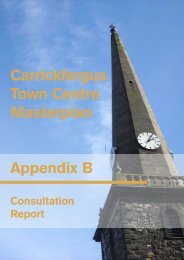start a growing club at your school - Carrickfergus in Bloom
start a growing club at your school - Carrickfergus in Bloom
start a growing club at your school - Carrickfergus in Bloom
Create successful ePaper yourself
Turn your PDF publications into a flip-book with our unique Google optimized e-Paper software.
START A GROWING CLUBAT YOUR SCHOOLWITHCARRICKFERGUS IN BLOOM
3.0 STEP BY STEP PLAN3.1 Gett<strong>in</strong>g StartedBefore pick<strong>in</strong>g up a spade, ask <strong>your</strong>self why you want to develop a Grow<strong>in</strong>gClub? Wh<strong>at</strong> will its purpose be? Wh<strong>at</strong> needs does <strong>your</strong> site have to fulfil? Write ast<strong>at</strong>ement of wh<strong>at</strong> you want <strong>your</strong> Grow<strong>in</strong>g Club to achieve and the potential usesit will offer the <strong>school</strong>. For example, the Grow<strong>in</strong>g Club could be a useful resourcefor pupils and teachers, both for recre<strong>at</strong>ion and as an external teach<strong>in</strong>g andlearn<strong>in</strong>g resource. Undertake a SWOT analysis for a Grow<strong>in</strong>g Club <strong>in</strong> <strong>your</strong><strong>school</strong>. Wh<strong>at</strong> are the strengths, weaknesses, opportunities and thre<strong>at</strong>s? This willhelp you to plan and understand the many opportunities th<strong>at</strong> a garden area canbr<strong>in</strong>g, as well as the challenges ahead.An example SWOT analysis by a <strong>school</strong>:Strengths‣ Back<strong>in</strong>g from the senior management team (SMT)‣ Supportive teach<strong>in</strong>g staff‣ Enthusiastic pupils‣ Good premises managerWeaknesses‣ Lack of space/equipment‣ Little support from parents‣ F<strong>in</strong>ancial constra<strong>in</strong>ts‣ Little knowledge of garden<strong>in</strong>gOpportunities‣ Draw <strong>in</strong> local community and parent <strong>in</strong>terest‣ Curriculum l<strong>in</strong>ks, e.g. food cha<strong>in</strong> issues‣ Fund rais<strong>in</strong>g‣ Raised beds, or adapted tools, for wheelchair usersThre<strong>at</strong>s‣ Safety‣ Holidays - who will w<strong>at</strong>er the plants?‣ Vandalism‣ Verm<strong>in</strong>3.2 Sett<strong>in</strong>g up a Grow<strong>in</strong>g ClubYou should share <strong>your</strong> early ideas and thoughts with the senior managementteam (SMT) and the School Council or School Nutrition Action Group (SNAG),l<strong>in</strong>k<strong>in</strong>g it to a Whole School Food Policy. You will need the support from theHeadteacher, SMT and/or governors and premises manager to ensure success.
The full particip<strong>at</strong>ion of pupils should also be considered <strong>in</strong> all stages ofconsult<strong>at</strong>ion and decision mak<strong>in</strong>g.Sett<strong>in</strong>g up the Grow<strong>in</strong>g Club, i.e. physically build<strong>in</strong>g the garden area, will takeseveral days of hard work, so advertise for will<strong>in</strong>g volunteers to share theworkload. Carry out a simple skills and equipment audit amongst the staff,governors and parents to establish wh<strong>at</strong> tools and expertise you already have.Recruit help by:‣ hold<strong>in</strong>g a special assembly;‣ produc<strong>in</strong>g a flyer with an <strong>in</strong>vit<strong>at</strong>ion for people to help out;‣ <strong>start</strong><strong>in</strong>g a Grow<strong>in</strong>g Club notice board;‣ advertis<strong>in</strong>g <strong>in</strong> the <strong>school</strong> newsletter to pupils and parents;‣ promot<strong>in</strong>g the idea on the <strong>school</strong> web-site or to the local media.Advertis<strong>in</strong>g for support should enable you to establish a Grow<strong>in</strong>g Club team tohelp take the project forward and avoid all the responsibility be<strong>in</strong>g on theshoulders of just one person. This is important for future susta<strong>in</strong>ability.Ensure the group <strong>in</strong>cludes pupils, teachers and, where possible, parents. Andremember <strong>Carrickfergus</strong> Borough Council is <strong>at</strong> hand should you require anyadvice or <strong>in</strong>form<strong>at</strong>ion.3.3 Wh<strong>at</strong> support do you need?‣ Ensure th<strong>at</strong> you have SMT/Governor commitment to the project.‣ Consider whether external organis<strong>at</strong>ions are needed to help you make theGrow<strong>in</strong>g Club a reality.‣ You may wish to visit other local <strong>school</strong>s th<strong>at</strong> have gardens or <strong>grow<strong>in</strong>g</strong><strong>club</strong>s and f<strong>in</strong>d out wh<strong>at</strong> lessons have they learned from the experience.‣ Go to the ‘Teacher Net’ web-site (www.teachernet.gov.uk) for support.Use the Grow<strong>in</strong>g Schools website for detailed <strong>in</strong>form<strong>at</strong>ion, curriculum l<strong>in</strong>ksand l<strong>in</strong>ks for further <strong>in</strong>form<strong>at</strong>ion.‣ Determ<strong>in</strong>e the need for tra<strong>in</strong><strong>in</strong>g and the level of external support requiredto make the Grow<strong>in</strong>g Club a success.‣ Ensure th<strong>at</strong> the <strong>school</strong>'s public liability <strong>in</strong>surance is <strong>in</strong> place and th<strong>at</strong> itcovers <strong>your</strong> activities.‣ Contact <strong>your</strong> local Healthy Schools co-ord<strong>in</strong><strong>at</strong>or to f<strong>in</strong>d out wh<strong>at</strong> support isavailable <strong>in</strong> <strong>your</strong> area.
‣ Involve outside groups from <strong>your</strong> local area. Ask the local allotment groupfor help.‣ Check for any local garden societies or local web forums and ask for theirsupport.3.4 Wh<strong>at</strong> roles will people have <strong>in</strong> the Grow<strong>in</strong>g Club?‣ Identify key job roles and responsibilities with<strong>in</strong> the team.‣ Def<strong>in</strong>e talents and expertise - is anybody a keen gardener? You may needto advertise for specific help.‣ Emphasise the l<strong>in</strong>ks the project has to the particular <strong>in</strong>terest of the personyou are try<strong>in</strong>g to get <strong>in</strong>volved, e.g. curriculum l<strong>in</strong>ks for a teacher.‣ Inform everybody about wh<strong>at</strong> you are do<strong>in</strong>g and wh<strong>at</strong> stage the project is<strong>at</strong>.‣ Approach <strong>Carrickfergus</strong> Borough Council for advice and freebies.‣ Check out BBC Neighbourhood gardener - a garden<strong>in</strong>g mentor<strong>in</strong>g schemewww.bbc.co.uk/garden<strong>in</strong>g/neighbourhood_gardener for any l<strong>in</strong>ks to <strong>your</strong>area.‣ Calcul<strong>at</strong>e the budget available. You may need to raise funds.‣ Make l<strong>in</strong>ks with local bus<strong>in</strong>ess or volunteer brokerage organis<strong>at</strong>ions th<strong>at</strong>can come <strong>in</strong>to <strong>school</strong> to help out set up the Grow<strong>in</strong>g Club area, e.g.erect<strong>in</strong>g a greenhouse, mak<strong>in</strong>g benches or raised beds.3.5 Plann<strong>in</strong>g <strong>your</strong> Grow<strong>in</strong>g ClubYour Grow<strong>in</strong>g Club team should develop an action plan, <strong>in</strong>clud<strong>in</strong>g the likely timeit will take to get the Grow<strong>in</strong>g Club established. Develop a month by month workplan, <strong>in</strong>clud<strong>in</strong>g wh<strong>at</strong> needs to be achieved, equipment and resources needed andwho is go<strong>in</strong>g to undertake the task.In addition, consider the follow<strong>in</strong>g questions:‣ Wh<strong>at</strong> activities need to take place and when? Which of these activities canbe completed by the <strong>school</strong> and for which activities will you need externalsupport?‣ Have you conducted a risk assessment for the Grow<strong>in</strong>g Club? Wh<strong>at</strong> arethe implic<strong>at</strong>ions to health and safety?
‣ w<strong>at</strong>er<strong>in</strong>g can/s,‣ hose,‣ compost b<strong>in</strong>,‣ project book and camera to record <strong>your</strong> work,‣ raised beds or m<strong>at</strong>erials to make raised beds (wood, hammer, nail, plasticl<strong>in</strong>er, wood protector and pa<strong>in</strong>t brush).You will need a range of tool sizes, <strong>in</strong>clud<strong>in</strong>g junior spades and small handtrowels for very young children. For wheelchair and/or physically impaired pupils,purchase adapted tools. Some tools might be don<strong>at</strong>ed from the community.There are a number of stockists of child sized tools, such as B& Q, Asda, Co-Opand various pound shops.3.8 Design<strong>in</strong>g <strong>your</strong> Grow<strong>in</strong>g Club AreaOnce you have secured fund<strong>in</strong>g, established where the garden area will be andrecruited people to help develop and ma<strong>in</strong>ta<strong>in</strong> the site, you will need to design<strong>your</strong> Grow<strong>in</strong>g Club area.‣ Develop a feel or theme to the area, e.g. multicultural or Victorian kitchengarden (see below for other themes to consider). Do you want to <strong>in</strong>clude<strong>in</strong>dividual beds, a tool shed, benches or a greenhouse?‣ Work with<strong>in</strong> the budget you have, but consider longer term aspir<strong>at</strong>ions andplans.‣ Sketch out the area, maybe as a pupil activity, look<strong>in</strong>g <strong>at</strong> the possibilitiesavailable for the area. Wh<strong>at</strong> would they like to see? A computer simul<strong>at</strong>orcould be used to give a rough concept - a free one is available from(www.bbc.co.uk/garden<strong>in</strong>g/design/virtualgarden_<strong>in</strong>dex.shtml)‣ Help pupils to design how the area will look <strong>in</strong> the future and wh<strong>at</strong>vegetables / fruit will be grown and when.‣ Include a compost<strong>in</strong>g area or wormery to encourage recycl<strong>in</strong>g and agre<strong>at</strong>er understand<strong>in</strong>g of lifecycles.‣ Ensure th<strong>at</strong> the area has wheelchair access.‣ Consider wh<strong>at</strong> resources you need, e.g. conta<strong>in</strong>ers, soil, tools, seeds,trees and storage.‣ Consider w<strong>at</strong>er, dra<strong>in</strong>age, ma<strong>in</strong>tenance and susta<strong>in</strong>ability <strong>in</strong> the future.While any food garden is a centrepiece for nutrition lessons cre<strong>at</strong><strong>in</strong>g them<strong>at</strong>icgardens to help pupils realise their power to control their own health and th<strong>at</strong> oftheir families through garden<strong>in</strong>g. Here is a few suggestions:
Cancer Prevention Gardens: Numerous published studies reveal th<strong>at</strong> peoplewho consume large quantities of fruits and vegetables are much less likely todevelop cancer than those who don't e<strong>at</strong> them consistently. A cancer preventiongarden should conta<strong>in</strong> abundant cabbage-family crops such as bok choy,broccoli, Brussels sprouts, cabbage, and mustard greens, which conta<strong>in</strong> acompound believed to stimul<strong>at</strong>e cancer-fight<strong>in</strong>g enzymes. Carrots, sweetpot<strong>at</strong>oes, pumpk<strong>in</strong>s, squash, sp<strong>in</strong>ach, red peppers, onions, and garlic are alsobelieved to have a range of cancer-fight<strong>in</strong>g properties.Cholesterol-Control Gardens: Although vegetables don't conta<strong>in</strong> cholesterol,scientists believe th<strong>at</strong> foods rich <strong>in</strong> soluble fibre, like many fruits and vegetables,may actually help to lower cholesterol levels and reduce the risk of heart <strong>at</strong>tacks.Such a garden would <strong>in</strong>clude crops rich <strong>in</strong> soluble fibre such as apples, drybeans, carrots, eggplant, greens, peas, pot<strong>at</strong>oes, and squash. Consider us<strong>in</strong>gthis garden focus as a spr<strong>in</strong>gboard for engag<strong>in</strong>g students to notice and perhapsrecord the f<strong>at</strong> and fibre contents of foods they e<strong>at</strong>.Herb Gardens: Many processed foods have high sodium levels th<strong>at</strong> can lead tohigh blood pressure and other problems. Consider <strong>grow<strong>in</strong>g</strong> a garden offlavour<strong>in</strong>gs such as basil, chives, dill, fennel, garlic, and m<strong>in</strong>t to use <strong>in</strong> place ofsalt.3.9 Decid<strong>in</strong>g wh<strong>at</strong> to growWhen decid<strong>in</strong>g wh<strong>at</strong> to grow, consult the pupils with a tast<strong>in</strong>g session and strikea balance between favourites like tom<strong>at</strong>oes, strawberries and fruit andvegetables pupils are less likely to have tried. Once the pupils have decided wh<strong>at</strong>to grow, help them f<strong>in</strong>d the seeds <strong>in</strong> a mail order c<strong>at</strong>alogue from which they canorder the plants and have them sent to themselves <strong>at</strong> the <strong>school</strong>. Buy somesmall plants (tom<strong>at</strong>oes and courgettes for example) to add to <strong>your</strong> garden.Pupils will want to see results quicker than n<strong>at</strong>ure allows. Keep <strong>in</strong>terest withmustard and cress or red cabbage seeds (sown one week and e<strong>at</strong>en the next),lettuce leaves, peas and early varieties of pot<strong>at</strong>oes (ready to harvest before theend of summer term) are all rel<strong>at</strong>ively quick <strong>grow<strong>in</strong>g</strong>. M<strong>in</strong>aret fruit trees producefruit <strong>in</strong> the 2nd year after plant<strong>in</strong>g. Herbs grow well <strong>in</strong> conta<strong>in</strong>ers, on thew<strong>in</strong>dowsill and <strong>in</strong> the garden.3.10 Runn<strong>in</strong>g <strong>your</strong> Grow<strong>in</strong>g Club‣ Timetable <strong>your</strong> activities to ensure th<strong>at</strong> everyone knows the plan and cantake on a specific role <strong>in</strong> order to get th<strong>in</strong>gs done.‣ L<strong>in</strong>k the project to healthier e<strong>at</strong><strong>in</strong>g and the curriculum.
‣ Ensure th<strong>at</strong> the project will go from strength to strength <strong>in</strong> the future andcan be susta<strong>in</strong>ed over time.3.11 Manag<strong>in</strong>g <strong>your</strong> Grow<strong>in</strong>g ClubOnce you have <strong>your</strong> equipment, make an <strong>in</strong>ventory. Always ensure th<strong>at</strong> theequipment is checked back <strong>in</strong> <strong>at</strong> the end of a session and leave time for toolclean<strong>in</strong>g.Do not underestim<strong>at</strong>e the enthusiasm of the children and the need to th<strong>in</strong>kthrough the Grow<strong>in</strong>g Club activity session <strong>in</strong> the same way as you approach alesson plan. Ensure th<strong>at</strong> you have adequ<strong>at</strong>e staff to monitor the space and thepupils <strong>in</strong>volved (no more than 8 - 10 pupils per adult).Week by week, month by month, you will need a range of outdoor activities, e.g.plant<strong>in</strong>g a fruit tree, fill<strong>in</strong>g a conta<strong>in</strong>er for tumbler tom<strong>at</strong>oes, sow<strong>in</strong>g seeds,weed<strong>in</strong>g, w<strong>at</strong>er<strong>in</strong>g, harvest<strong>in</strong>g and a range of <strong>in</strong>door activities, such as design<strong>in</strong>glabels, cre<strong>at</strong><strong>in</strong>g art and writ<strong>in</strong>g poems about the garden, cre<strong>at</strong><strong>in</strong>g a scarecrow,writ<strong>in</strong>g to a garden centre for don<strong>at</strong>ions, mak<strong>in</strong>g <strong>in</strong>vit<strong>at</strong>ions for the open day,keep<strong>in</strong>g records us<strong>in</strong>g a spreadsheet. Plan ahead to ensure th<strong>at</strong> pupils havesometh<strong>in</strong>g to do.3.12 Top Tips‣ Leave plenty of time. Plan carefully before you <strong>start</strong> where, when and whowill be <strong>in</strong>volved.‣ Start plann<strong>in</strong>g and prepar<strong>in</strong>g the area <strong>in</strong> the autumn term so when th<strong>in</strong>gswarm up <strong>in</strong> the spr<strong>in</strong>g you can get <strong>your</strong> plants and seeds ready.‣ Share the vision. Ask for specific help from the <strong>school</strong> community.‣ Make sure there are <strong>at</strong> least 2 people <strong>in</strong> the co-ord<strong>in</strong><strong>at</strong><strong>in</strong>g team andensure someone is alloc<strong>at</strong>ed enough time to undertake the work <strong>in</strong>volved.‣ Organise regular work days.‣ Ensure th<strong>at</strong> you have plenty of volunteers.‣ If you do not have space <strong>in</strong> <strong>your</strong> <strong>school</strong> grounds make l<strong>in</strong>ks with localallotments.‣ Grow pot<strong>at</strong>oes - you get a lot for <strong>your</strong> money and you can do lots withthem.‣ Choose some fast <strong>grow<strong>in</strong>g</strong> crops, e.g. peas, runner beans and courgettes.
‣ Try <strong>grow<strong>in</strong>g</strong> seeds <strong>in</strong> the classroom, establish<strong>in</strong>g w<strong>in</strong>dow boxes, pots,hang<strong>in</strong>g baskets, conta<strong>in</strong>ers and grow-bags. If you have no grounds, it isamaz<strong>in</strong>g wh<strong>at</strong> you can grow <strong>in</strong> very little space!‣ Make raised beds. They look gre<strong>at</strong>, are easy to ma<strong>in</strong>ta<strong>in</strong> and can beplaced <strong>in</strong> <strong>school</strong>s which only have tarmac. They are also wheelchairfriendly.‣ Plan the '<strong>grow<strong>in</strong>g</strong>' <strong>in</strong>to <strong>your</strong> <strong>school</strong> curriculum, e.g. Science, FoodTechnology, Geography.‣ Do not view it as an 'add on' to the <strong>school</strong>, but as someth<strong>in</strong>g <strong>in</strong>tegral to itsethos.‣ Start small and be realistic! Do not be too ambitious. Just one strip ofcarrots may be enough to get everyone excited.‣ Do not be afraid to <strong>start</strong> even if you do not have a clear idea about wh<strong>at</strong>the <strong>club</strong> will look like <strong>in</strong> 6 months.‣ Ensure th<strong>at</strong> you have activities for ra<strong>in</strong>y days. This could <strong>in</strong>volve look<strong>in</strong>g <strong>at</strong>and tast<strong>in</strong>g different fruits and vegetables, plann<strong>in</strong>g <strong>grow<strong>in</strong>g</strong> areas andus<strong>in</strong>g the <strong>in</strong>ternet for <strong>in</strong>spir<strong>at</strong>ion.3.13 Promot<strong>in</strong>g <strong>your</strong> Grow<strong>in</strong>g ClubTo promote <strong>your</strong> Grow<strong>in</strong>g Club, you could:‣ add <strong>your</strong> Grow<strong>in</strong>g Club to the <strong>Carrickfergus</strong> Council website;‣ cre<strong>at</strong>e a display <strong>in</strong> the <strong>school</strong>;‣ keep a video diary to play <strong>in</strong> assembly;‣ encourage visitors to visit the Grow<strong>in</strong>g Club area;‣ <strong>in</strong>vite parents and the local community to view, or take part <strong>in</strong>, the <strong>club</strong>;‣ grow unusual fruits and vegetables to keep pupil <strong>in</strong>terest;‣ make a <strong>school</strong> Grow<strong>in</strong>g Club scrapbook;‣ organise an open-house with local <strong>school</strong>s to help them look <strong>at</strong> thepotential for their <strong>school</strong>s;‣ write topical fe<strong>at</strong>ures <strong>in</strong> the <strong>school</strong> newsletter.
‣ promote the Grow<strong>in</strong>g Club <strong>in</strong> the <strong>school</strong> newsletter, web-site orprospectus;‣ organise a launch event to open the 'garden' area <strong>at</strong> <strong>school</strong>. You could<strong>in</strong>vite the local mayor, MP or a celebrity.3.14 Evalu<strong>at</strong><strong>in</strong>g SuccessIt is important to review and monitor <strong>your</strong> Grow<strong>in</strong>g Club to evalu<strong>at</strong>e its impact.You could:‣ keep track of wh<strong>at</strong> you have done and compare it to <strong>your</strong> orig<strong>in</strong>alst<strong>at</strong>ement of activity;‣ look <strong>at</strong> wh<strong>at</strong> th<strong>in</strong>gs are work<strong>in</strong>g and wh<strong>at</strong> are not and alter the project asappropri<strong>at</strong>e;‣ consider whether you need extra support with some aspects of the project;‣ keep the project varied and <strong>in</strong>terest<strong>in</strong>g to ma<strong>in</strong>ta<strong>in</strong> enthusiasm andmotiv<strong>at</strong>ion of all those <strong>in</strong>volved.3.15 Grow<strong>in</strong>g Club ForumAs a member of the ‘<strong>Carrickfergus</strong> Schools Grow<strong>in</strong>g Clubs’ forum <strong>your</strong> <strong>school</strong> willbe <strong>in</strong>vited to a meet<strong>in</strong>g once or twice a year to discuss with other members <strong>your</strong>successes and failures. It is hoped the forum will become a valuable arena formembers to learn from each other and ensure their <strong>grow<strong>in</strong>g</strong> <strong>club</strong>s grow year onyear.4.0 GROWING CLUB CHECKLIST[] Have you identified the benefits of a Grow<strong>in</strong>g Club for <strong>your</strong> <strong>school</strong>?[] Are you clear about wh<strong>at</strong> you want to achieve?[] Have you <strong>in</strong>volved the School Governers & PTA?[] Have you engaged the full particip<strong>at</strong>ion of pupils <strong>at</strong> all stages?[] Have you talked to the senior management team and got their support?[] Is the premises manager supportive of the Grow<strong>in</strong>g Club?[] Have you completed a SWOT analysis[] Have you decided where the Grow<strong>in</strong>g Club will be loc<strong>at</strong>ed?
[] Have you determ<strong>in</strong>ed who will hold key jobs, roles and responsibilities?[] Have you identified sources of fund<strong>in</strong>g?[] Have you developed an action plan?[] Have you designed <strong>your</strong> Grow<strong>in</strong>g Club area?[] Have you conducted a risk assessment and chosen wh<strong>at</strong> to grow?[] Have you checked equipment and resources?[] Have you planned a str<strong>at</strong>egy to promote <strong>your</strong> Grow<strong>in</strong>g Club?[] Have you planned how you will monitor and evalu<strong>at</strong>e the impact of <strong>your</strong>Grow<strong>in</strong>g Club?5.0 INTEGRATING INTO SCHOOLS PROJECTS & CURRICULUM‣ There are many n<strong>at</strong>ural l<strong>in</strong>ks which can be made to other SchoolsProjects, depend<strong>in</strong>g on <strong>your</strong> <strong>school</strong>. L<strong>in</strong>ks to <strong>your</strong> Grow<strong>in</strong>g Clubs <strong>in</strong>clude:‣ Pupils <strong>at</strong>tend<strong>in</strong>g breakfast <strong>club</strong> could help to w<strong>at</strong>er the garden <strong>in</strong> themorn<strong>in</strong>g.‣ Some pupils could e<strong>at</strong> their lunch <strong>in</strong> the garden, if appropri<strong>at</strong>e se<strong>at</strong><strong>in</strong>g isavailable. The <strong>grow<strong>in</strong>g</strong> area could be used as a stimulus to <strong>in</strong>spire pupilsabout their own lunchbox.‣ The garden could grow food exclusively for the <strong>school</strong> tuck shop.‣ Small items, such as cherry tom<strong>at</strong>oes and carrot sticks could be sold.‣ If you have a glut of fruit or vegetables, the cookery <strong>club</strong> could use theseto make a variety of tasty dishes.‣ Cre<strong>at</strong>e an outdoors garden feel to the d<strong>in</strong><strong>in</strong>g room, e.g. photographs offruit and vegetables could be used for decor<strong>at</strong>ion <strong>in</strong> the <strong>school</strong> d<strong>in</strong><strong>in</strong>groom.‣ Grow<strong>in</strong>g Clubs provides a context for a wide variety of curriculum l<strong>in</strong>ks,see figure one below:
Northern Neighbourhoods Health Action Zone http://www.nnhaz.co.ukThe Northern Neighbourhoods Health Action Zone (NNHAZ) is a community ledpartnership <strong>in</strong>iti<strong>at</strong>ive th<strong>at</strong> aims to improve the health and social well-be<strong>in</strong>g ofpeople and communities liv<strong>in</strong>g with<strong>in</strong> the Northern Health and Social ServicesBoard area.Health Promotion Agency http://www.healthpromotionagency.org.ukThe Health Promotion Agency has the mission ‘to make health a top priority foreveryone <strong>in</strong> Northern Ireland.’ The website has a wealth of local <strong>in</strong>form<strong>at</strong>ion tosupport those work<strong>in</strong>g <strong>in</strong> the areas of health promotion and public health.East Antrim Local Health & Social Care Group http://www.ealhscg.n-i.nhs.ukA website dedic<strong>at</strong>ed to those who have an <strong>in</strong>volvement or <strong>in</strong>terest <strong>in</strong> the healthand social well be<strong>in</strong>g of people <strong>in</strong> the East Antrim (<strong>Carrickfergus</strong>, Larne,Newtownabbey) areas.Food <strong>in</strong> Schools www.food<strong>in</strong><strong>school</strong>s.orgThe Food <strong>in</strong> Schools website conta<strong>in</strong> further m<strong>at</strong>erials such as templ<strong>at</strong>es, casestudies and posters to support you <strong>in</strong> develop<strong>in</strong>g <strong>your</strong> Grow<strong>in</strong>g Club and otherrel<strong>at</strong>ed healthier e<strong>at</strong><strong>in</strong>g and dr<strong>in</strong>k<strong>in</strong>g activities <strong>in</strong> <strong>your</strong> <strong>school</strong>. The most up to d<strong>at</strong>em<strong>at</strong>erials can be found on the website.The Royal Horticultural Society (RHS) www.rhs.org.ukBrita<strong>in</strong>'s garden<strong>in</strong>g charity, with an extensive web-site, free <strong>school</strong>s membershipscheme, advice and seeds. RHS Onl<strong>in</strong>e has a wealth of <strong>in</strong>form<strong>at</strong>ion - <strong>in</strong>clud<strong>in</strong>gRHS Plant F<strong>in</strong>der and RHS Plant Selector - on plants for all situ<strong>at</strong>ions and how togrow them to perfection.BBC Garden<strong>in</strong>g www.bbc.co.uk/garden<strong>in</strong>g/design/virtualgarden_<strong>in</strong>dexshtmlLots of advice and guidance with a useful and free virtual garden designerprogram.Department for Educ<strong>at</strong>ion www.teachernet.gov.uk/<strong>grow<strong>in</strong>g</strong><strong>school</strong>sGrow<strong>in</strong>g Schools is a government programme which aims to harness the fullpotential of the outdoor classroom as a teach<strong>in</strong>g and learn<strong>in</strong>g resource.Eco Schools www.eco-<strong>school</strong>s.org.ukEco Schools is a gre<strong>at</strong> way to make susta<strong>in</strong>able development a part of the lifeand ethos of <strong>your</strong> <strong>school</strong>. Designed to fit <strong>in</strong>to the curriculum, it's an award
scheme th<strong>at</strong> gets everyone <strong>in</strong> the <strong>school</strong> community <strong>in</strong>volved <strong>in</strong> mak<strong>in</strong>g the<strong>school</strong> environment better.Farm<strong>in</strong>g and Countryside Educ<strong>at</strong>ion www.face-onl<strong>in</strong>e.org.ukHelps young people learn more about food and farm<strong>in</strong>g <strong>in</strong> a susta<strong>in</strong>ablecountryside, through farm visits and <strong>in</strong>form<strong>at</strong>ion support.Feder<strong>at</strong>ion of City Farms and Community Gardens www.farmgarden.org.ukThe Feder<strong>at</strong>ion of City Farms and Community Gardens (FCFCG) can tell you ifthere is there a local farm or community garden near <strong>your</strong> <strong>school</strong>.Global Action Pan www.globalactionplan.orgGlobal Action Plan is an <strong>in</strong>dependent charity which runs an Action <strong>at</strong> Schoolenvironmental programme and supports recycl<strong>in</strong>g and compost<strong>in</strong>g.Groundwork www.groundwork.org.ukGroundwork is a lead<strong>in</strong>g environmental regener<strong>at</strong>ion charity mak<strong>in</strong>g susta<strong>in</strong>abledevelopment a reality <strong>in</strong> communities <strong>in</strong> the UK which are <strong>in</strong> need of <strong>in</strong>vestmentand support.N<strong>at</strong>ional Trust www.n<strong>at</strong>ionaltrust.org.uk/plottopl<strong>at</strong>eThe N<strong>at</strong>ional Trust's Plot to Pl<strong>at</strong>e learn<strong>in</strong>g <strong>in</strong>iti<strong>at</strong>ive, takes place <strong>at</strong> Trustproperties, looks <strong>at</strong> <strong>grow<strong>in</strong>g</strong> and prepar<strong>in</strong>g food.Henry Doubleday Research Associ<strong>at</strong>ion www.hdra.org.ukProvides advice on organic garden<strong>in</strong>g and downloadable resources, posters,public<strong>at</strong>ions and a section th<strong>at</strong> is upd<strong>at</strong>ed termly with ideas and activities basedon wh<strong>at</strong> to do <strong>in</strong> the <strong>grow<strong>in</strong>g</strong> area <strong>at</strong> th<strong>at</strong> time of year.Learn<strong>in</strong>g through Landscapes www.ltl.org.ukLearn<strong>in</strong>g through Landscapes is the n<strong>at</strong>ional <strong>school</strong> grounds charity. Amembership organis<strong>at</strong>ion support<strong>in</strong>g <strong>school</strong>s who want to develop their <strong>school</strong>grounds. Case studies available and lots of l<strong>in</strong>ks to the formal curriculumavailable for both primary and secondary.Soil Associ<strong>at</strong>ion www.soilassoci<strong>at</strong>ion.org.ukProvides <strong>in</strong>form<strong>at</strong>ion and support for <strong>school</strong>s, <strong>in</strong>clud<strong>in</strong>g details on farm visits,classroom resources and teacher workshops.
MEMBER APPLICATION FORMApplicant Details (Please Pr<strong>in</strong>t)School / Group NameContact NameHeadmasterContact AddressTel.Email.Post codeApplicant Sign<strong>at</strong>ure ______________________D<strong>at</strong>e __________________Headmaster Sign<strong>at</strong>ure _____________________ D<strong>at</strong>e __________________<strong>Carrickfergus</strong> Borough Council use onlyD<strong>at</strong>e ReceivedAcknowledgement SentDevelopment CommitteeParks CommitteeFull CouncilPhoto Call(Return to: Stephen Daye, <strong>Carrickfergus</strong> Borough Council, Civic Centre, 10Antrim Street, <strong>Carrickfergus</strong>, BT38 7DG.)
<strong>Carrickfergus</strong> <strong>in</strong> <strong>Bloom</strong><strong>Carrickfergus</strong> Museum & Civic Centre.Antrim Street<strong>Carrickfergus</strong>BT38 7DGt: (028) 9335 8039f: (028) 9336 6676e: <strong>in</strong>bloom@carrickfergus.org
















